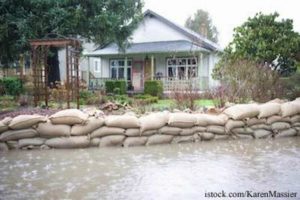It’s flood safety week and the U.S. Food and Drug Administration (FDA) has compiled some information including food safety tips during a flood. Doing a small amount of preparation can save a lot of time and hassle.
 Pay attention to weather forecasts when a lot of rain is predicted. Officials will often issue flood watches before the weather becomes really severe.
Pay attention to weather forecasts when a lot of rain is predicted. Officials will often issue flood watches before the weather becomes really severe.
Prepare for a flood by buying jugs of water and shelf-stable foods that can feed your family for a few days and store them in an area flood waters are not likely to reach. Keep a jug of liquid bleach and a cooler in the same area. Find out where you can purchase dry ice.
If your home floods, use bottled water that has not been exposed to flood waters. If you run out of bottled water, boil tap water for one minute, let it cool and store it in clean, covered containers. If you can’t boil the tap water, add 1/8 tsp bleach to one gallon, stir and let its stand for 30 minutes before using. If the water is still cloudy, filter it through clean cloths or allow it to settle and then draw the clear water from the top. Don’t drink water from a well that has been flooded.
Don’t eat any food that was directly exposed to flood water or any food from non-waterproof containers or damaged cans. Food from metal cans that were exposed to flood waters can be eaten if the cans are undamaged and washed in a solution of 1 tablespoon household bleach in 1 gallon water for 15 minutes. Use the same bleach solution to wash pans, dishes, utensils, can openers and countertops.
And only use food from cans or food packages that are hermetically sealed. Food containers that are not safe, even if they are soaked in bleach, include screw tops, snap lids, crimped caps, twist caps, flip tops, and snap-open lids. Only save foods that are packed in commercially canned containers.




